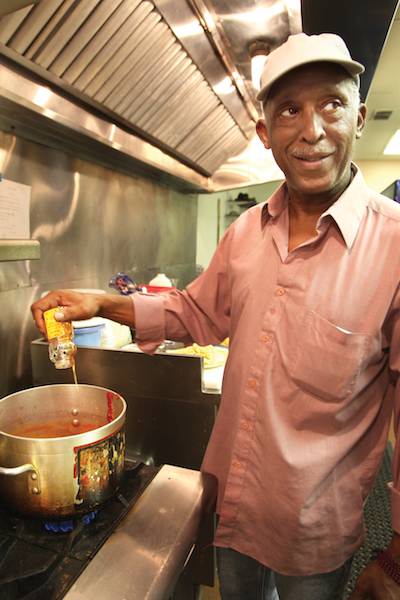“I have a system, and I like to stick to it—it’s not having one. This is an expensive meal, this. It cost me $50 to buy all this stuff. I like to cook with palm oil, and it’s really not good for you. It’s saturated. So I cut it with olive oil, which is good for you. It’s the taste of the palm oil I want. It really has a flavor, and you can capture the flavor without having too much of it.
This doesn’t take long to cook. It needs to be a fish that’s not going to fall apart. And I use mushrooms to substitute for meat and make the dish more bountiful, so you can feed more people. This is a Yoruban dish. The person who taught me how to make this is from Nigeria. But I’ve put my own twist to it, because my relatives are from Louisiana, as far back as the 1700s. Donaldsonville, Napoleonville, Plaquemines; my family comes off of the plantation called Belle Helene, also called the Ashland plantation. I represent the black side of the Kenner family, which no one talks about. Two brothers, Duncan Kenner and George Kenner, owned the plantation. George Kenner is my great great grandfather. My great great grandmother, who was a slave, had seven kids by him.
I like to put honey in this, a little Oshun. It’s not in the recipe the guy gave me, but I tried it. Just to sweeten it a little, and it does something. Also, he didn’t put shrimp in it. I’m putting shrimp in this, with the fish. I’ve even taken the same dish and put sausage in it, and that made it taste even better. This is an African dish and it’s really close to things that are cooked here in New Orleans, with the exception of the palm oil.
You know Big Chief Donald Harrison? I use some of his tricks. When he makes gumbo, and I know because we spent a lot of time on the road together, everything he puts in it, he cooks it so it tastes good before he puts it in the gumbo. Sausage, he doesn’t just drop it into the gumbo; he cooks it in a skillet. He takes the shrimp and cook them first, then put them in. Even the crabs. And it makes a big difference.
You don’t want to stir this. You just shake the pot like the washing machine, so the fish will stay whole. And the spinach just sits on top.
And now we’re going to make fufu. Fufu, better explained, is F-U, F-U [laughs]. I really can’t tell you, and spelling it doesn’t sound good, I’m saying some bad words to you. I don’t know. It’s pounded yam, and I got this powder from the same guy who brought me the palm oil. I think it’s an acquired taste. I don’t think it’s something that people necessarily like, but I just like African food.
You know what I think? I think when black people came here to the States, their substitute for fufu was grits. I really do. I think there’s a serious similarity in preparing the grits and this, and some people like their grits thick, like fufu.
What I really like about the fufu is that you eat it with your fingers. When I grew up, you couldn’t eat with your fingers. You had to use a fork and knife. So just the thrill of being able to stick my hands in it, I think that’s one of the reasons.
The trick with fufu is mixing it, getting the water to accept it. I have no idea how much water I have in here, I just add as much powder as I need. Now we have a volcano going on. Here’s the thing—you have to get all the dryness out of it, all the little lumps, which is why I don’t particularly like the fufu process. It’s kind of rough. For this to be ready, I have to work it. When the pot is taller, you can mash it up against the side, but this takes a good fifteen minutes. You have to keep on until it’s smooth. You smash it and smash it. I have seen people work this stuff for a good half hour to forty-five minutes. Fufu will keep you strong! If I had to make this to order, I would have a fufu-less restaurant. It’s tedious. But God, talk about good!”
Eja Eba (Yoruban Fish Stew)
2 tablespoons palm oil
2 tablespoons olive oil
5 tilapia fillets, cut in half
1 pack mushrooms, sliced
1 pound peeled shrimp
1 cup water 1 (29-ounce) can tomato sauce
1 (6-ounce) can tomato paste
2 habañero peppers, finely minced
1 teaspoon salt
2 tablespoons honey
1/2 pound fresh spinach
Fry tilapia fillets in palm oil and olive oil until done. Remove fish from pan and set aside. Fry mushrooms, then set aside. Fry shrimp, and set aside. Deglaze the pan with water, and mix with tomato sauce and tomato paste. Bring sauce to a slow boil. Add peppers, salt and honey. Simmer for 10 minutes. Gently place fish, shrimp and mushrooms into sauce. Do not stir—just shake the pot. Simmer for 5 minutes. Place spinach leaves on top, turn off the heat and cover the pot—do not stir the spinach in, it should just steam on top. Serve with fufu, or rice.
Note: Instead of mincing the habañeros, you can put them in whole to get some of the flavor but almost no heat, and then simply remove them before adding the fish.





